Simulation of Solidification Structure in the Vacuum Arc Remelting Process of Titanium Alloy TC4 Based on 3D CAFE Method
Abstract
1. Introduction
2. Solidification Structure Model
2.1. Mathematical Model
2.1.1. Heat Transfer Model
2.1.2. Flow Model
2.1.3. Solute Diffusion Model
2.1.4. Nucleation Model
2.1.5. Grain Growth Model
2.2. Composition and Physical Properties of the TC4 Titanium Alloy
2.3. Model Parameters and Boundary Conditions
3. Result Analysis and Discussion
3.1. Changes in the Temperature Field and Solid Fraction during the Melting Process
3.2. Changes in the Solidification Structure of the Ingot during Melting
3.3. Effects of Different Bulk Nucleation Parameters on the Solidification Structure of Ingots
3.3.1. Effect of Maximum Bulk Nucleation Undercooling on the Solidification Structure of Ingots
3.3.2. Effect of the Maximum Nucleation Density on the Solidification Structure of an Ingot
3.3.3. The Influence of the Maximum Bulk Nucleation Standard Deviation on the Solidification Structure
3.4. Comparison between the Simulated and Experimental Results
4. Conclusions
- (1)
- After the start of smelting, the depth of the molten pool gradually increases, and the shape of the molten pool gradually evolves from a flat shape to a funnel shape until a stable molten pool is formed. The depth of the molten pool reaches a maximum of 171.4 mm, and then the depth of the molten pool remains unchanged.
- (2)
- The solidification structure of the vacuum arc remelting process at different times is obtained via a simulation. There are typically three crystal zones in the solidification structure of the ingot: the surface fine crystal zone, columnar crystal zone, and central equiaxed crystal zone.
- (3)
- The maximum body nucleation undercooling has a significant effect on the different crystal regions of the solidification structure of the ingot. The larger the maximum body nucleation undercooling, the larger the proportion of the columnar crystal region; when the maximum nucleation undercooling increases from 3 K to 8 K, the number of grains in the solidified structure decreases by 82.2%.
- (4)
- With the increase in the maximum bulk nucleation density, the equiaxed grain zone gradually increases, the grain size becomes smaller, and the columnar grain zone is suppressed. When the maximum bulk nucleation density increases from 5 × 107 to 5 × 109, the number of grains in the solidified structure increases by 91.8%. The maximum volume nucleation variance has no obvious effect on the change in the solidification structure.
- (5)
- When the maximum bulk nucleation undercooling is 5.5 K, the standard deviation of nucleation is 4 K, and the maximum bulk nucleation density is 5 × 108. The solidification structure simulation results are in good agreement with the experimental results.
Author Contributions
Funding
Data Availability Statement
Conflicts of Interest
References
- Guo, L.; He, W.; Zhou, P.; Liu, B. Research Status and Development Prospect of Titanium and Titanium Alloy Products in China. J. Hot Work. Technol. 2020, 49, 22–28. [Google Scholar]
- Dong, J.; Chen, J.; Wang, D.; Li, X. Study on Composition and Microstructure of TC4 Titanium Alloy. J. Heilongjiang Metall. 2014, 34, 6–9. [Google Scholar]
- Chen, W.; Wang, J.; Kong, Y. Analysis of Research Progress on Properties of Titanium Alloys TC4. Mod. Chem. Res. 2023, 51–53. [Google Scholar] [CrossRef]
- Yang, J.; Zhang, K.; Cao, J.; Liu, H.; Li, W. Research on Preparation of Oversized TC4 ELI Titanium Alloy Ingots by VAR. Titan. Ind. Prog. 2023, 40, 1–5. [Google Scholar]
- Yuan, W. Comparative Analysis on Melting Process of TC4 Titanium Alloy. J. Nonferrous Met. Process. 2018, 47, 23–27. [Google Scholar]
- Lei, W.; Zhao, Y.; Han, D.; Mao, X. Development of Melting Technology for Titanium and Titanium Alloys. J. Mater. Rep. 2016, 30, 101–106. [Google Scholar]
- Yang, H.; Yang, X.; Du, C.; Yuan, Z.; Wei, F.; Luo, B.; Wang, H. Recent development in researching the advanced melting processes for Titanium Alloy. World Nonferrous Met. 2019, 1–4+6. [Google Scholar]
- Li, M.; Yang, S.; Liu, W.; Jia, L.; Zhao, P.; Yan, Y. Research process on segregation and control of titanium alloy during vacuum arc remelting. China Metall. 2023, 33, 1–10+18. [Google Scholar]
- Wang, Y.; Zhang, L.; Zhang, J.; Zhou, Y.; Liu, T.; Ren, Y. Numerical simulation of macrosegregation in vacuum arc remelting process. J. Iron Steel Res. 2021, 33, 718–725. [Google Scholar]
- Luo, W.; Zhao, X.; Liu, P.; Wu, W.; He, Y.; Wang, K.; Hao, F. Computational Simulation of Factors Affecting Surface Quality of Titanium Alloy Ingot in VAR Process. J. Rare Met. Mater. Eng. 2020, 49, 927–932. [Google Scholar]
- Kondrashov, E.; Rusakov, K.; Leder, M. VAR ingot solidifification model and its verifification: Application to titanium Ti-10V-2Fe-3Al alloy. J. Eur. Phys. J. Spec. Top. 2020, 229, 485–494. [Google Scholar] [CrossRef]
- Pericleous, K.; Djambazov, G.; Ward, M.; Yuan, L.; Lee, P.D. A Multiscale 3D Model of the Vacuum Arc Remelting Process. Met. Mater. Trans. A 2013, 44, 5365–5376. [Google Scholar] [CrossRef]
- Kondrashov, E.N.; Leder, M.O.; Maksimov, A.Y. Maksimov. Simulation of the VT3-1 Alloy Ingot Solidification during VAR. J. Russ. Metall. (Met.) 2018, 12, 1114–1120. [Google Scholar] [CrossRef]
- Leder, M.O.; Gorina, A.V.; Kornilova, M.A.; Tarenkova, N.Y.; Kondrashov, E.N. Determination of the Thermophysical Properties of Titanium Alloys from Liquid Bath Profiles. J. Russ. Metall. (Met.) 2015, 12, 964–969. [Google Scholar] [CrossRef]
- Kondrashov, E.N.; Musatov, M.I.; Maksimov, A.Y.; Goncharov, A.E.; Konovalov, L.V. Calculation of the molten pool depth in vacuum arc remelting of alloy Vt3-1. J. Eng. Thermophys. 2007, 16, 19–25. [Google Scholar] [CrossRef]
- Boivineau, M.; Cagran, C.; Doytier, D.; Eyraud, V.; Nadal, M.H.; Wilthan, B.; Pottlacher, G. Thermophysical Properties of Solid and Liquid Ti-6Al-4V(TA6V) Alloy. J. Int. J. Thermophys. 2006, 27, 507–529. [Google Scholar] [CrossRef]
- Jia, L.; Cui, H.; Yang, S.; Lv, S.; Xie, X.; Qu, J. Effect of the cooling rates on the microstructure and segregation characteristics in directionally solidified GH4151 superalloy. Mater. Charact. 2024, 209, 113735. [Google Scholar] [CrossRef]
- Yan, Y.; Gu, Y.; Jia, L.; Zhao, P.; Li, M.; Yang, S. Microstructure evolution behavior in electroslag remelting ingot of GH3536 alloy. China Metall. 2024, 1–15. [Google Scholar] [CrossRef]
- Li, H.; Li, H.; Kou, H.; Zhong, H.; Chang, H.; Li, J. Prediction of solidification microstructure in γ-TiAl alloys ingots during Vacuum Arc Remelting. Spec. Cast. Nonferrous Alloys 2012, 32, 901–904. [Google Scholar]
- An, R.; Liu, F.; Chen, K.; Gao, J.; Kang, C.; Jiang, Z. CAFÉ simulation of electroslag remelting GH984G directional solidification structure. Iron Steel 2021, 56, 56–64+71. [Google Scholar]
- Cheng, A.; Ma, Y.; Gao, X.; Li, J.; Yang, S.; Bai, L. Numerical simulation on consumable-electrode vacuum melting process for 14Cr-13Co-5Mo-2Ni gear steel. Spec. Steel 2014, 35, 23–25. [Google Scholar]
- Zhao, P.; Zheng, L.; Yang, S.; Liu, W.; Li, J.; Yang, S.; Chen, Y. Microstructure characteristics and mechanical properties of a novel heavy density Ni–W–Co matrix alloy prepared by VIM/VAR. J. Mater. Res. Technol. 2021, 13, 2459–2468. [Google Scholar] [CrossRef]
- Atwood, R.C.; Lee, P.D.; Minisandram, R.S.; Jones, R.M.F. Multiscale modelling of microstructure formation during vacuum arc remelting of titanium 6-4. J. Mater. Sci. 2004, 39, 7193–7197. [Google Scholar] [CrossRef]
- Yuan, L.; Djambazov, G.; Lee, P.D.; Pericleous, K. Multiscale modeling of the vacuum arc remelting process for the prediction on microstructure formation. Int. J. Mod. Phys. B 2009, 23, 1584–1590. [Google Scholar] [CrossRef]
- Zhang, Y.; Kou, H.; Li, P.; Zhong, H.; Hu, R.; Li, J.; Zhou, L. Simulation on Solidification Structure and Shrinkage Porosity (Hole) in TC4 Ingot during Vacuum Arc Remelting Process. Spec. Cast. Nonferrous Alloys 2012, 32, 418–421. [Google Scholar]
- Bai, L.; Liu, H.; Zhang, Y.; Miao, X.; Ruan, X. Numerical simulation of the microstructure of 22CrMoH billets and the effects of alloying elements. Chin. J. Eng. 2011, 33, 1091–1098. [Google Scholar]
- Huang, Y.; Yang, M.; Li, J. Evolution and control of bearing-steel microstructures in Vacuum Consumable Melting. Chin. J. Vac. Sci. Technol. 2016, 36, 727–730. [Google Scholar]
- Lan, P.; Sun, H.; Li, Y.; Zhang, J. 3D CAFE model for simulating the solidification microstructure of 430 stainless steel. Chin. J. Eng. 2014, 36, 315–322. [Google Scholar]
- Zhao, X.; He, Y.; Luo, W.; Lai, Y.; Wang, K.; Liu, X. Numerical Simulation of the VAR Process of Ti-1023 Alloy Ingot with Melt Flow-VAR and Validation. Mater. China 2018, 37, 367–371. [Google Scholar]
- Güther, V.; Rothe, C.; Winter, S.; Clemens, H. Metallurgy, microstructure and properties of intermetallic TiAl ingots. BHM Berg-Und Hüttenmännische Monatshefte 2010, 7, 325–329. [Google Scholar] [CrossRef]
- Miao, F.; Xie, L.; Li, J.; Tian, R.; Wang, R.; Kang, Y.; Yan, Z. Simulation of Ingot Solidification Microstructure Evolution of Cu-3Ni-0.96Si-0.15Mg Alloy Based on CAFE. Hot Work. Technol. 2024, 135–140. [Google Scholar] [CrossRef]
- Lv, B.; Li, Z.; Yang, Z.; Liu, X.; Li, W.; Han, J. Effect of ESR Process on the Solidification Structure of GCr15 Bearing Steel. Mater. Rep. 2021, 35, 24134–24141. [Google Scholar]


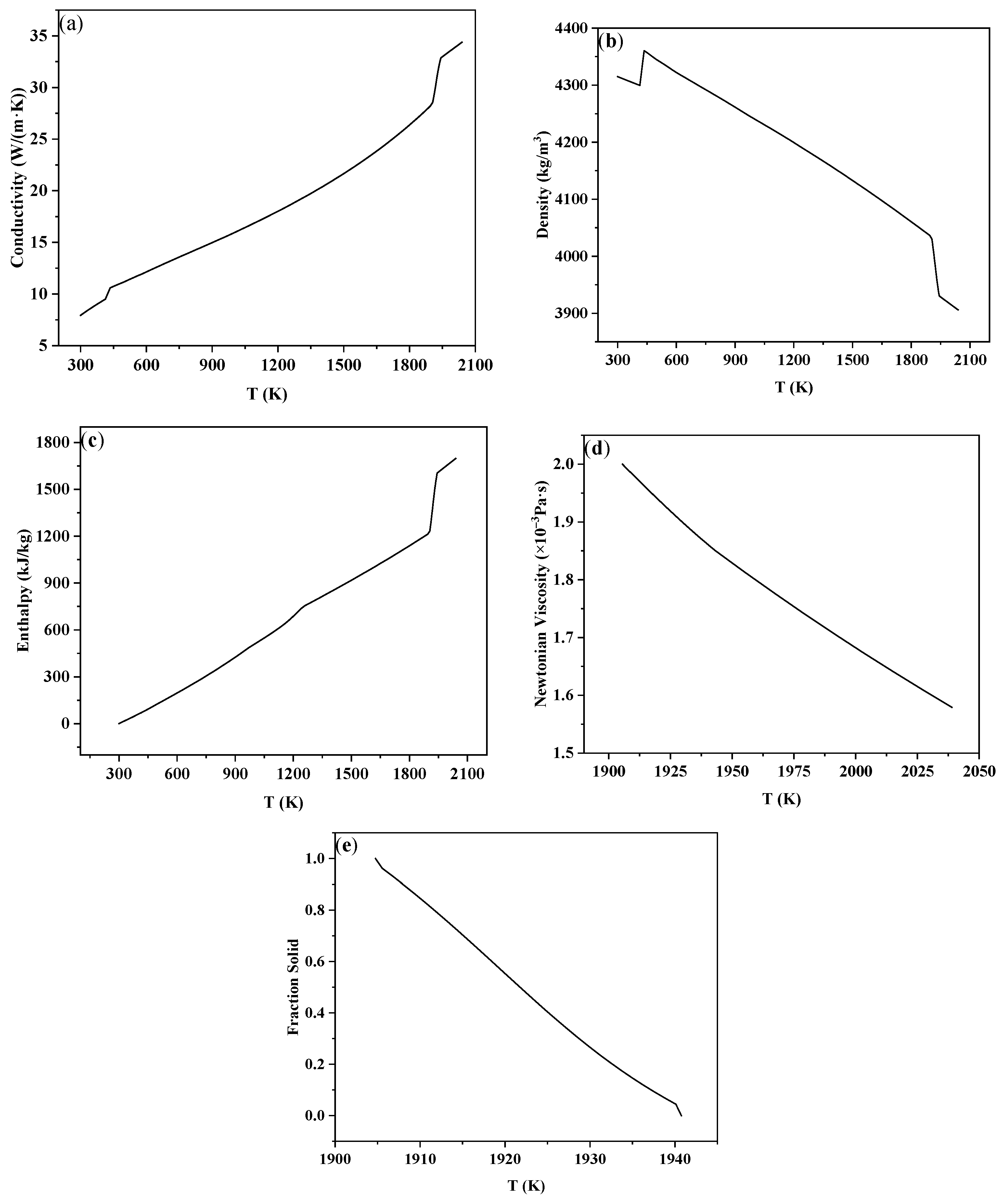
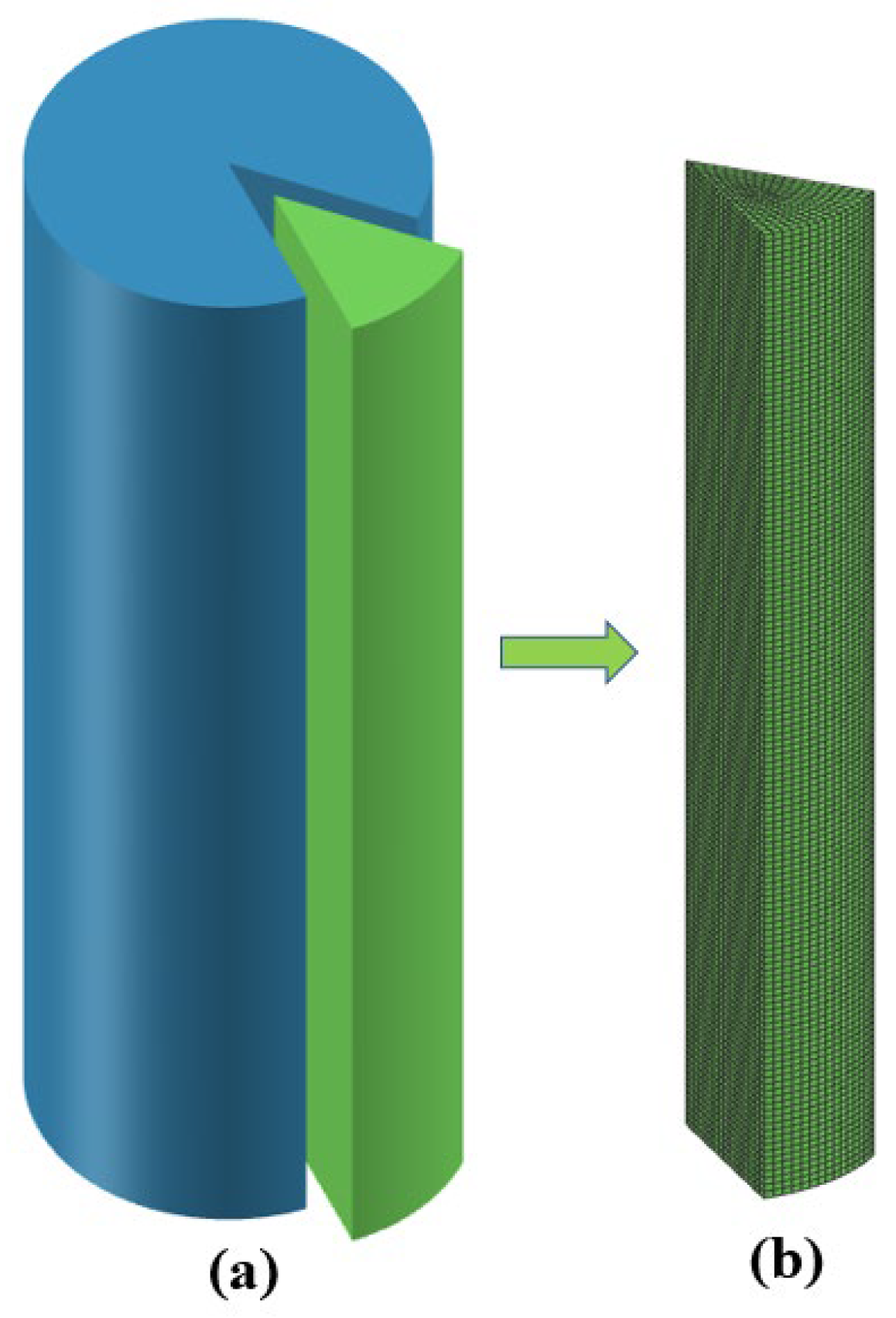
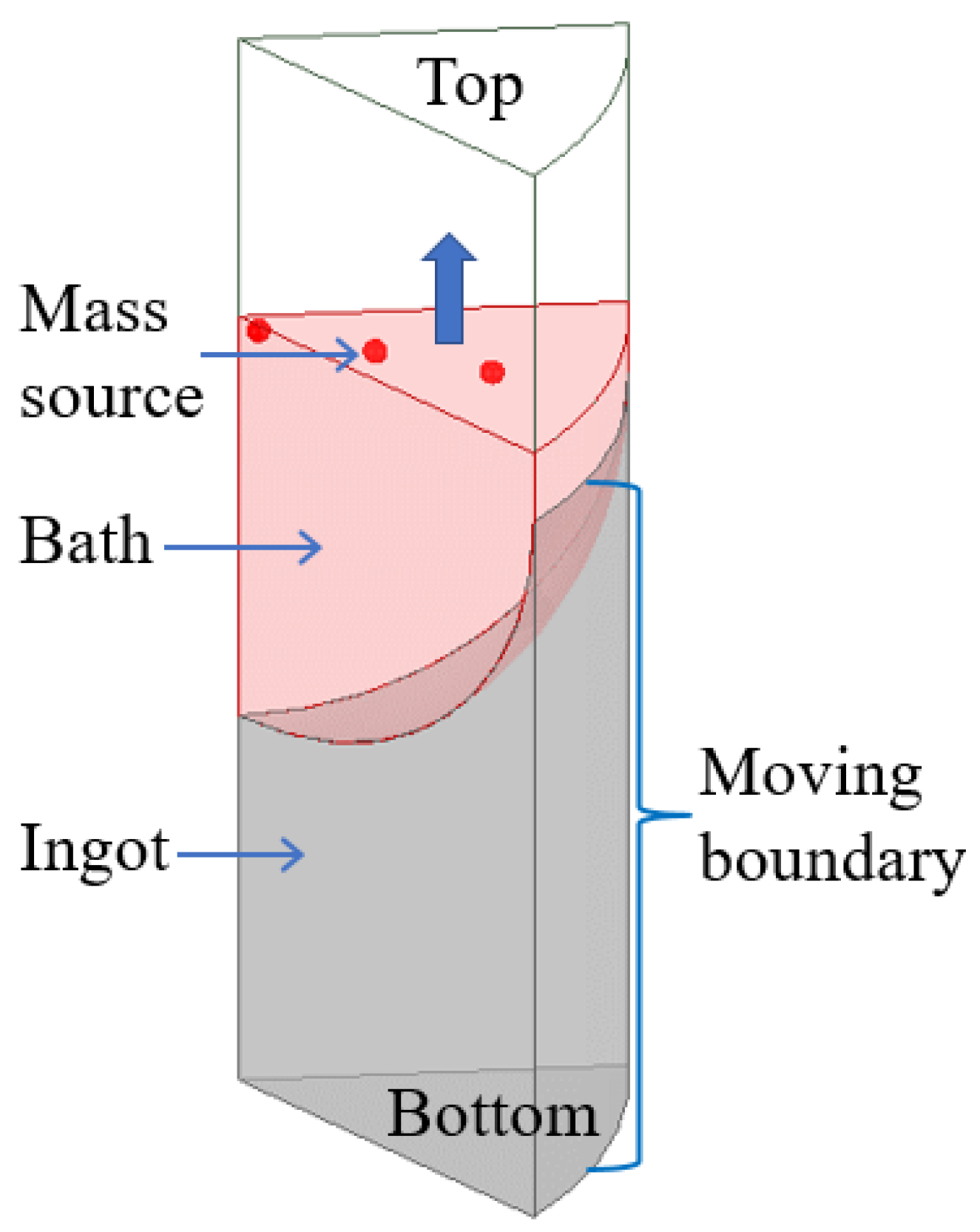

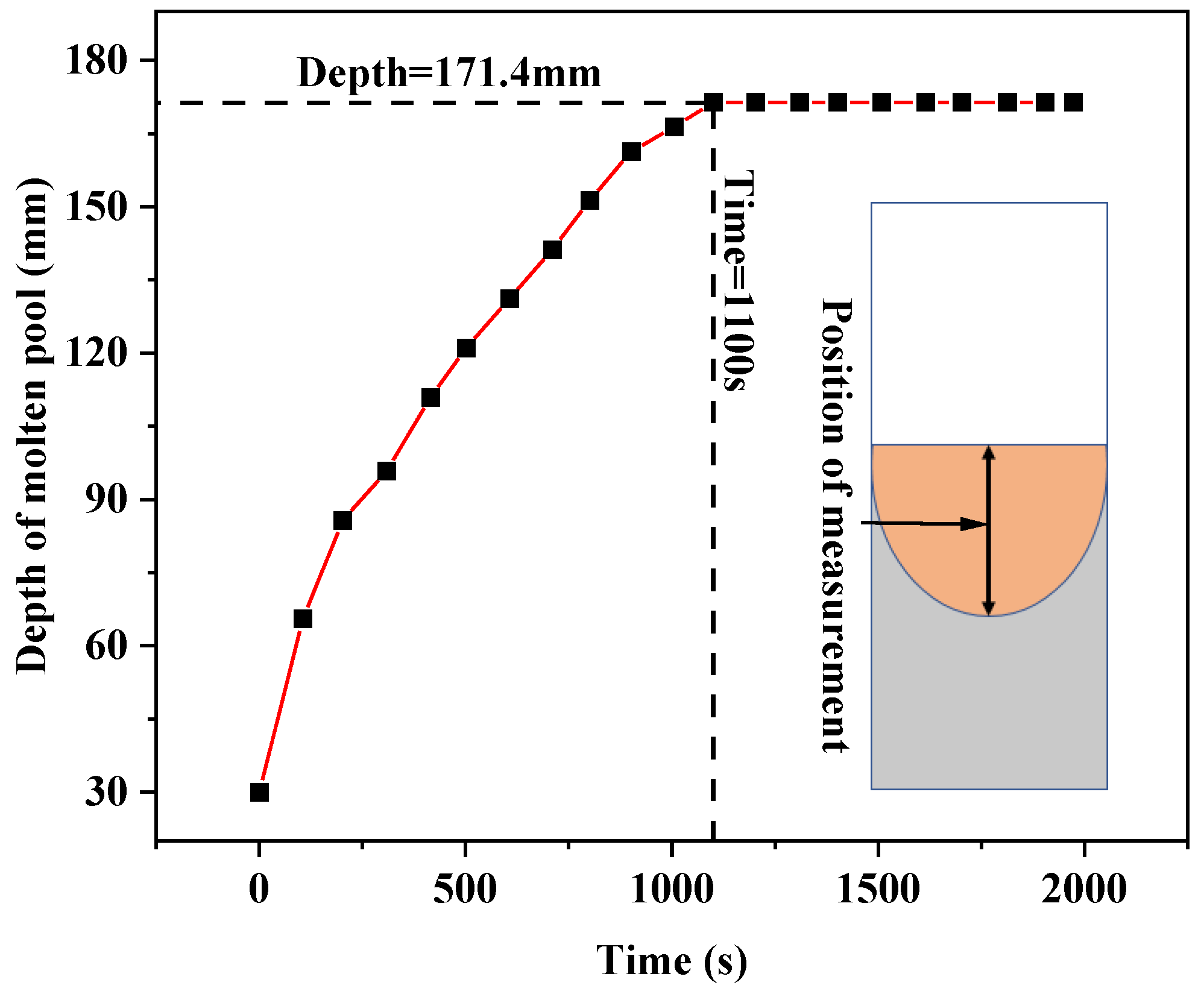
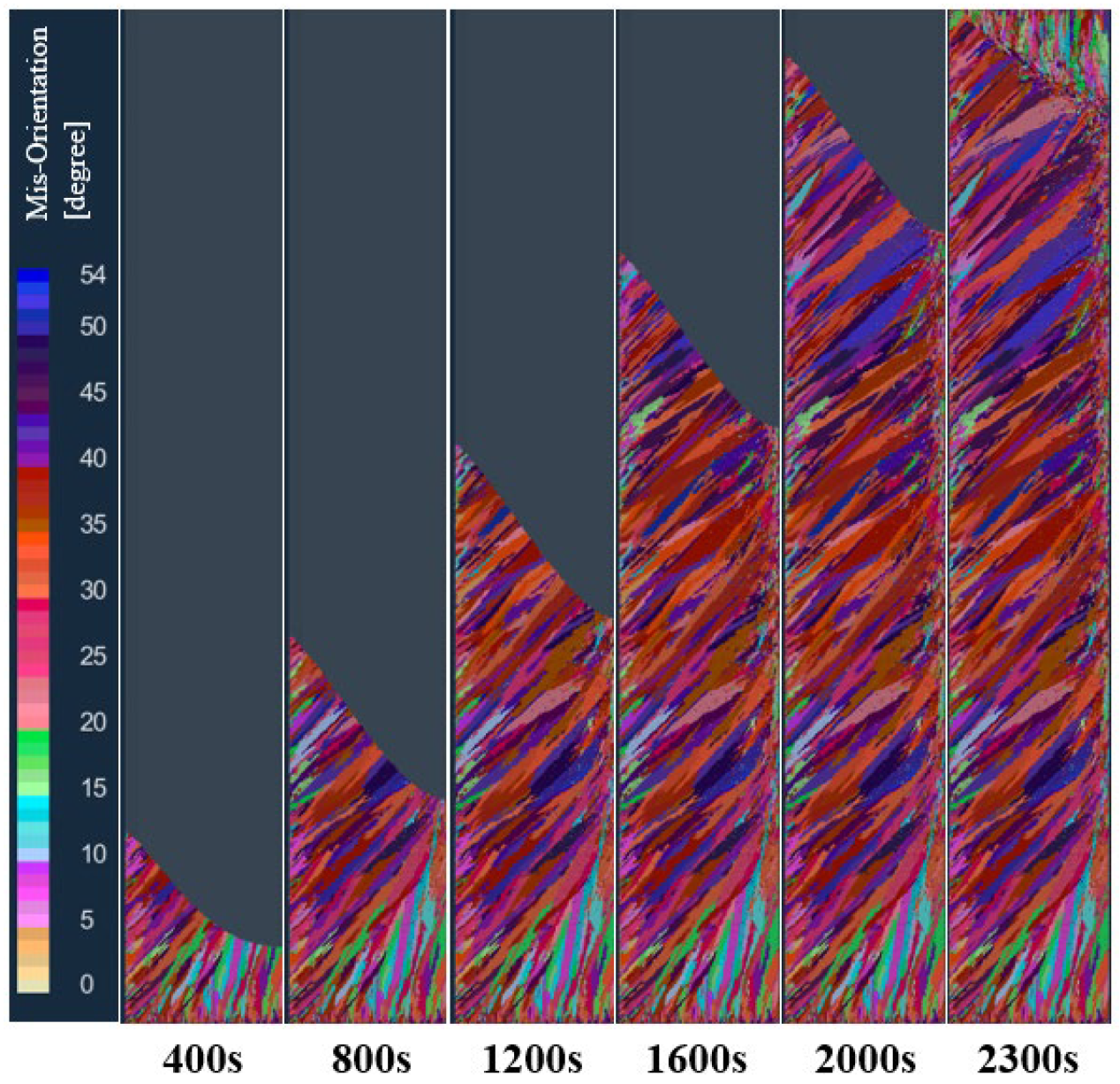
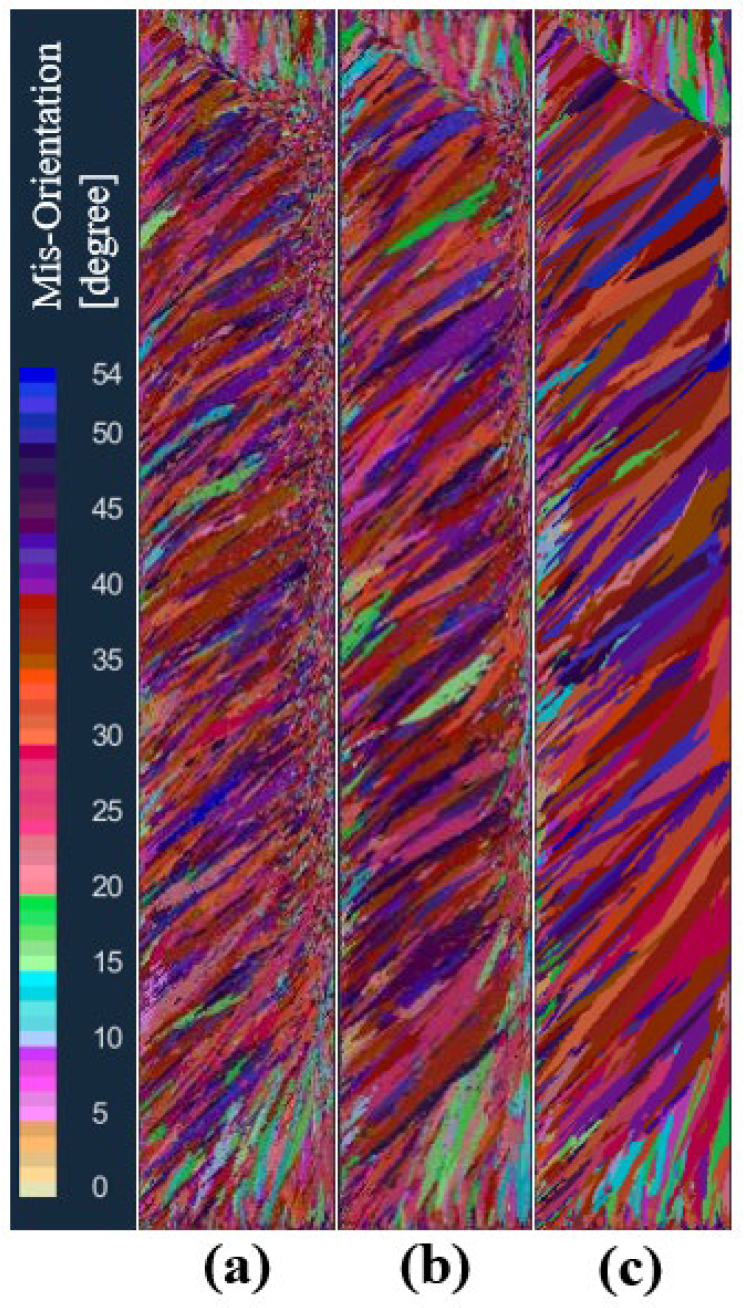



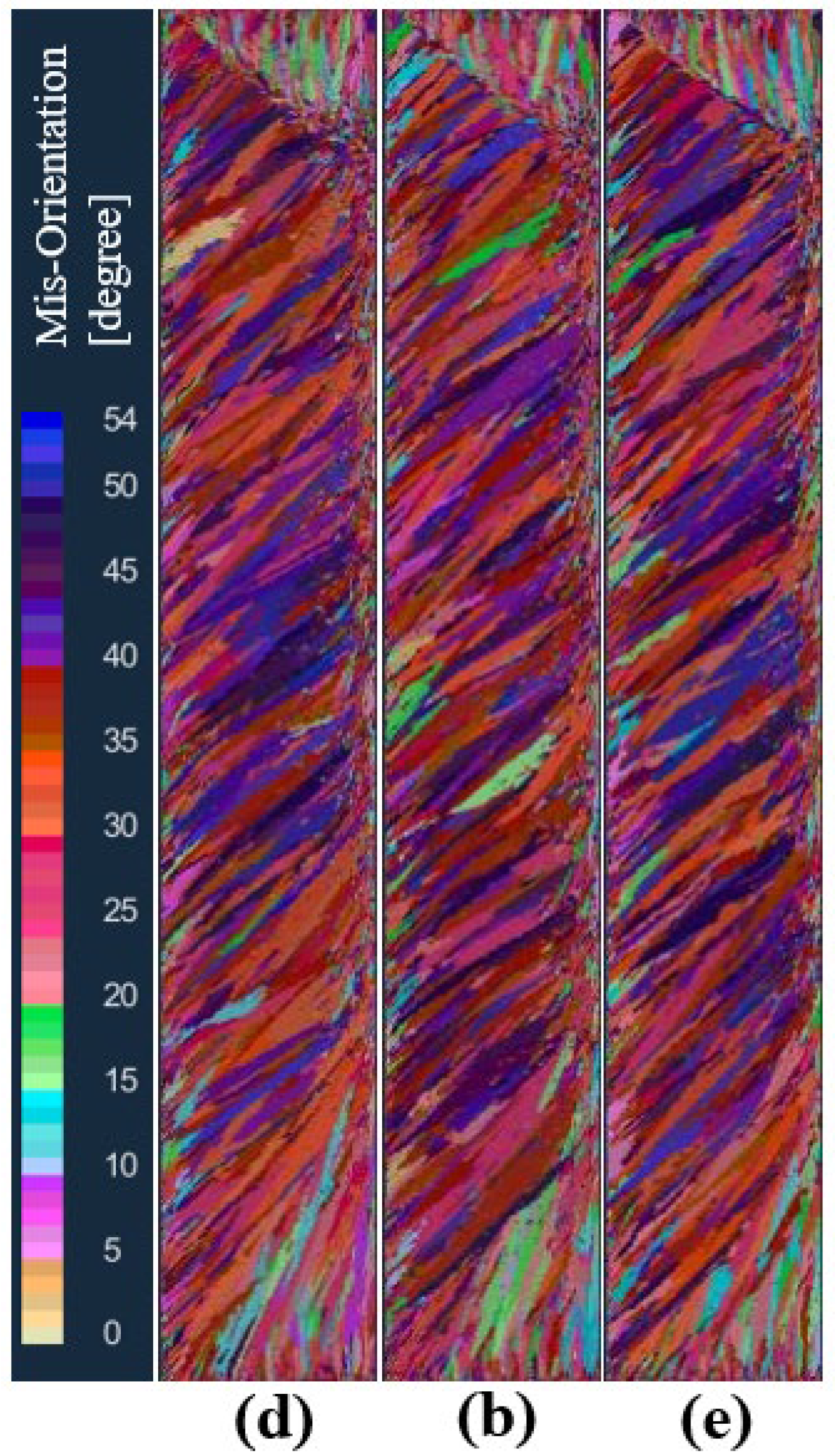
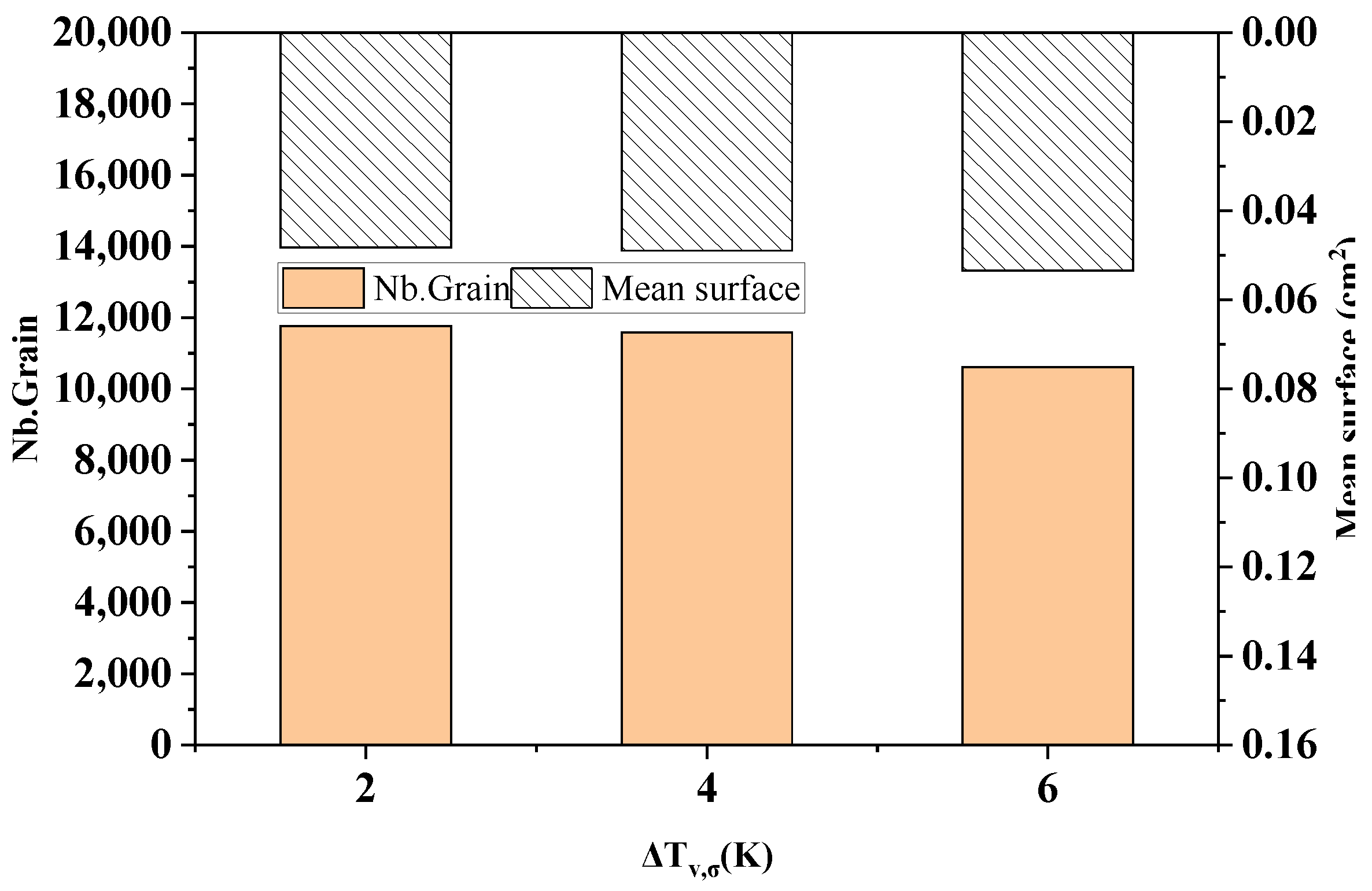

| Brand | Chemical Composition (Mass Fraction) % | ||||
|---|---|---|---|---|---|
| Ti | Al | V | Fe | O | |
| TC4 | Rest | 6.2 | 4.2 | 0.18 | 0.15 |
| Parameter | Value |
|---|---|
| Ingot diameter/mm | 190 |
| Ingot height/mm | 600 |
| Melting current/kA | 4.5 |
| Melting voltage/V | 30 |
| Melting speed/m∙s−1 | 0.00028 |
| Mass source flow/kg∙s−1 | 0.00095 |
| Schemes | Body Nucleation Parameters | ||
|---|---|---|---|
| /K | /K | ||
| a | 3 | 4 | 5 × 108 |
| b | 5.5 | 4 | 5 × 108 |
| c | 8 | 4 | 5 × 108 |
| d | 5.5 | 2 | 5 × 108 |
| e | 5.5 | 6 | 5 × 108 |
| f | 5.5 | 4 | 5 × 107 |
| g | 5.5 | 4 | 5 × 109 |
Disclaimer/Publisher’s Note: The statements, opinions and data contained in all publications are solely those of the individual author(s) and contributor(s) and not of MDPI and/or the editor(s). MDPI and/or the editor(s) disclaim responsibility for any injury to people or property resulting from any ideas, methods, instructions or products referred to in the content. |
© 2024 by the authors. Licensee MDPI, Basel, Switzerland. This article is an open access article distributed under the terms and conditions of the Creative Commons Attribution (CC BY) license (https://creativecommons.org/licenses/by/4.0/).
Share and Cite
Jing, Z.; Liu, R.; Geng, N.; Wang, Y.; Sun, Y. Simulation of Solidification Structure in the Vacuum Arc Remelting Process of Titanium Alloy TC4 Based on 3D CAFE Method. Processes 2024, 12, 802. https://doi.org/10.3390/pr12040802
Jing Z, Liu R, Geng N, Wang Y, Sun Y. Simulation of Solidification Structure in the Vacuum Arc Remelting Process of Titanium Alloy TC4 Based on 3D CAFE Method. Processes. 2024; 12(4):802. https://doi.org/10.3390/pr12040802
Chicago/Turabian StyleJing, Zhenquan, Rui Liu, Naitao Geng, Ying Wang, and Yanhui Sun. 2024. "Simulation of Solidification Structure in the Vacuum Arc Remelting Process of Titanium Alloy TC4 Based on 3D CAFE Method" Processes 12, no. 4: 802. https://doi.org/10.3390/pr12040802
APA StyleJing, Z., Liu, R., Geng, N., Wang, Y., & Sun, Y. (2024). Simulation of Solidification Structure in the Vacuum Arc Remelting Process of Titanium Alloy TC4 Based on 3D CAFE Method. Processes, 12(4), 802. https://doi.org/10.3390/pr12040802





